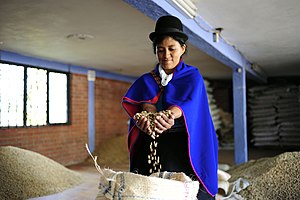Coffee production in Colombia/ja: Difference between revisions
Created page with "===影響=== thumb|[[:en:Quimbaya, Quindío|キンバヤ、キンディオのコーヒー農園]] 大規模農園を襲った危機は、コロンビアのコーヒー産業に最も大きな変化の一つをもたらした。1875年以来、サンタンデール県だけでなく、アンティオキア県の一部地域や旧カルダスとして言及される地域でも、小規模コーヒー生産..." |
Created page with "===ファン・バルデス=== {{main/ja|Juan Valdez/ja}}{{Excerpt|Juan Valdez/ja|paragraph=2}}" Tags: Mobile edit Mobile web edit |
||
| (13 intermediate revisions by 2 users not shown) | |||
| Line 42: | Line 42: | ||
大規模農園を襲った危機は、コロンビアのコーヒー産業に最も大きな変化の一つをもたらした。1875年以来、サンタンデール県だけでなく、[[:en:Antioquia Department|アンティオキア県]]の一部地域や旧カルダスとして言及される地域でも、小規模コーヒー生産者の数が成長し始めていた。20世紀の最初の数十年間には、国内の内部移住と、主にアンティオキア県、カルダス県、[[:en:Valle del Cauca Department|バジェ県]]、[[:en:Tolima Department|トリマ県]]北部といった国の中央および西部地域での新たな領土の植民地化に支えられ、農村経済に基づいたコーヒー輸出開発の新しいモデルがすでに確立されていた。この新しいコーヒーモデルの拡大と、大規模農園を襲った危機の両方により、コロンビア西部地域は国内のコーヒー産業発展において主導権を握ることとなった。 | 大規模農園を襲った危機は、コロンビアのコーヒー産業に最も大きな変化の一つをもたらした。1875年以来、サンタンデール県だけでなく、[[:en:Antioquia Department|アンティオキア県]]の一部地域や旧カルダスとして言及される地域でも、小規模コーヒー生産者の数が成長し始めていた。20世紀の最初の数十年間には、国内の内部移住と、主にアンティオキア県、カルダス県、[[:en:Valle del Cauca Department|バジェ県]]、[[:en:Tolima Department|トリマ県]]北部といった国の中央および西部地域での新たな領土の植民地化に支えられ、農村経済に基づいたコーヒー輸出開発の新しいモデルがすでに確立されていた。この新しいコーヒーモデルの拡大と、大規模農園を襲った危機の両方により、コロンビア西部地域は国内のコーヒー産業発展において主導権を握ることとなった。 | ||
この変革は、コーヒー市場に参入していた小規模コーヒー農園の所有者にとって非常に好都合であった。コーヒー栽培は、土地を永続的かつ集約的に利用できる可能性を提供したため、地元の農家にとって非常に魅力的な選択肢であった。焼畑方式に基づいたこの伝統的な農業の生産モデルでは、土地は長期間にわたって不生産のままであった。対照的に、コーヒーは、主要な技術的要件なしに、かつ自給作物の栽培を犠牲にすることなく、集約的な農業を行う可能性を提供し、こうして小規模農場が支配する新しいコーヒー文化の拡大のための条件を生み出した。 | |||
===20世紀=== | |||
[[File:NP_coffee_cooperative_(5867722870).jpg|left|thumb|コロンビアの[[:en:Smallholding|小規模]]コーヒー農家が[[:en:agricultural cooperative|農業協同組合]]にコーヒーを提供している。協同組合は小規模農家に市場、特に多くの購入者が市場を操作できる大企業であるコーヒーやカカオのような商品作物において、より競争力を高める機会を与えている。]] | |||
[[File:NP_coffee_cooperative_(5867722870).jpg|left|thumb| | 1913年、コロンビアは100万袋(60kg入り)のコーヒーを輸出した。これは1930年までに300万袋、1937年までに400万袋、1943年までに500万袋、1953年までに600万袋以上に増加した。 | ||
この新しいタイプのコーヒーは、国の農民によって作られ、現在の国際価格の変動の中で著しい成長能力を示したが、コロンビアはこの製品の世界市場において相対的に重要な活力を有していなかった。1905年から1935年の期間、コロンビアのコーヒー産業は、1927年に設立されたコロンビア国立コーヒー生産者連盟(Federación Nacional de Cafeteros de Colombia)の創設から派生したビジョンと長期的な政策のおかげで、ダイナミックに成長した。 | |||
連盟を中心とした地元の農民と小規模生産者の連合により、彼らは個別では不可能であった物流上および商業上の困難に立ち向かうことができた。時を経て、1938年に設立されたCenicaféでの研究と連盟の農業普及サービスを通じて、栽培システムが改善された。より効率的な空間パターンが開発され、製品の差別化と品質の維持が可能になった。現在、コロンビアのコーヒーの土地は、国内のすべての山脈およびその他の山岳地域を含み、50万を超えるコーヒー農家世帯に収入をもたらしている。 | |||
==気候変動{{Anchor|Climate change}}== | |||
==Climate change== | {{Further/ja|:en:Effects of climate change on agriculture}} | ||
{{Further|Effects of climate change on agriculture}} | 2011年のニューヨーク・タイムズ紙の記事では、[[:en:global warming|地球温暖化]]に関連する地域的な[[:en:climate change|気候変動]]により、コロンビアのコーヒー生産量が2006年から2010年の間に標準的な単位である1200万袋から900万袋に減少したと主張された。その記事によると、1980年から2010年の間に平均気温が1度上昇し、過去数年間で平均降水量が25パーセント増加したことで、''[[Coffea arabica/ja|アラビカ種]]''豆の特定の気候条件が阻害されたという。しかし、コロンビアのコーヒー生産量は2011年から2018年にかけて大幅に増加し、1420万袋となった。 | ||
==コロンビアのコーヒー栽培軸{{Anchor|Colombian coffee growing axis}}== | |||
==Colombian coffee growing axis== | {{main/ja|:en:Colombian coffee growing axis}} | ||
{{main|Colombian coffee growing axis}} | コーヒー栽培軸({{langx|es|link=no|Eje Cafetero}})は、コーヒーの三角地帯({{langx|es|link=no|Triángulo del Café}})としても知られ、コロンビアの[[:en:Paisa region|パイサ地域]]の一部である。この地域には、[[:en:Caldas Department|カルダス県]]、[[:en:Quindío Department|キンディオ県]]、[[:en:Risaralda Department|リサラルダ県]]の3つの県がある。これらの県は、コロンビアの県の中でも最小規模であり、総面積は13,873平方キロメートル(5,356平方マイル)で、コロンビア国土の約1.2%を占める。総人口は2,291,195人(2005年国勢調査)である。2011年、ユネスコはこの地域を世界遺産に登録した。 | ||
< | <span id="Marketing"></span> | ||
== Marketing == | == マーケティング{{Anchor|Marketing}} == | ||
===コロンビア国立コーヒー生産者連盟=== | |||
=== | {{main/ja|:en:National Federation of Coffee Growers of Colombia}} | ||
{{main|National Federation of Coffee Growers of Colombia}} | |||
コロンビア国立コーヒー生産者連盟は、非営利の事業組合であり、「[[Juan Valdez/ja|フアン・バルデス]]」のマーケティングキャンペーンで広く知られている。この連盟は、コロンビアコーヒーの生産と輸出を促進する事業協同組合として1927年に設立された。現在、50万以上の生産者を代表しており、そのほとんどが小規模な家族経営農場である。連盟は、地元の大学への助成金や連盟が後援する研究機関を通じて、コーヒー生産における研究開発を支援している。また、連盟は生産を監視し、輸出品質基準が満たされていることを確認している。連盟は3つの目的を持って設立された。1) 産業を保護すること、2) その問題を研究すること、3) その利益を促進することである。フアン・バルデスのブランドコンセプトは、100%コロンビアコーヒーを他の国の豆とブレンドされたコーヒーと区別するために1981年に開発された。この商標は、ラバにコーヒーを運ぶ農家の姿を描いて1983年にテレビで初めて登場した。 | |||
===ファン・バルデス=== | |||
{{main/ja|Juan Valdez/ja}}{{Excerpt|Juan Valdez/ja|paragraph=2}} | |||
===ナショナル・コーヒー・パーク=== | |||
{{Main/ja|National Coffee Park/ja}}{{Excerpt|National Coffee Park/ja|paragraph=2}} | |||
==関連項目== | |||
{{portal|Coffee|Colombia}} | {{portal|Coffee|Colombia}} | ||
*[[Astrid Medina]] | * [[:en:Astrid Medina|アストリッド・メディナ]] | ||
*[[2013 Colombian coffee growers strike]] | * [[:en:2013 Colombian coffee growers strike|2013年コロンビアコーヒー生産者ストライキ]] | ||
*[[List of countries by coffee production]] | * [[:en:List of countries by coffee production|コーヒー生産国の一覧]] | ||
==外部リンク== | |||
* {{commons category-inline|Coffee in Colombia}} | * {{commons category-inline|Coffee in Colombia}} | ||
* [https://whc.unesco.org/en/list/1121 Coffee Cultural Landscape of Colombia], UNESCO, unesco.org | * [https://whc.unesco.org/en/list/1121 Coffee Cultural Landscape of Colombia], UNESCO, unesco.org | ||
* [https://en.samariaorganic.com/ Coffee production in Sierra Nevada de Santa Marta]. | * [https://en.samariaorganic.com/ Coffee production in Sierra Nevada de Santa Marta]. | ||
{{Colombia topics}} | {{Colombia topics}} | ||
{{Treasures of Colombia}} | {{Treasures of Colombia}} | ||
{{coffee|nocat=1}} | {{coffee/ja|nocat=1}} | ||
{{Coffee production}} | {{Coffee production/ja}} | ||
[[Category:Agriculture in Colombia]] | [[Category:Agriculture in Colombia]] | ||
[[Category:Coffee in Colombia]] | [[Category:Coffee in Colombia]] | ||
| Line 125: | Line 95: | ||
[[Category:Economy of Colombia]] | [[Category:Economy of Colombia]] | ||
[[Category:Products with protected designation of origin]] | [[Category:Products with protected designation of origin]] | ||
{{二次利用|date=26 May 2025, at 05:03}} | {{二次利用/ja|date=26 May 2025, at 05:03}} | ||
Latest revision as of 12:29, 3 June 2025

| UNESCO World Heritage Site | |
|---|---|
 | |
| Location | コロンビア |
| Reference | 1121 |
| Inscription | 2011 (35th Session) |
| Area | 141,120 ha (348,700 acres) |
| Buffer zone | 207,000 ha (510,000 acres) |
| Coordinates | 5°28′18″N 75°40′54″W / 5.47167°N 75.68167°WCoordinates: 5°28′18″N 75°40′54″W / 5.47167°N 75.68167°W |
コロンビアのコーヒー生産は、マイルドでバランスの取れたコーヒー豆を生産することで知られている。コロンビアの年間平均コーヒー生産量は1,150万袋で、ブラジル、ベトナムに次ぐ世界第3位であるが、アラビカ豆に限れば世界一です。コロンビア産コーヒー豆は、アメリカ、ドイツ、フランス、日本、イタリアに輸出されている。ほとんどのコーヒーはコロンビアのコーヒー栽培地域で栽培されているが、シエラネバダ・デ・サンタマルタのような他の地域では、量よりも品質に重点を置いている。2007年には、欧州連合がコロンビアコーヒーに原産地名称保護制度を付与した。2011年には、ユネスコがコロンビアの「コーヒー文化景観」を世界遺産に登録した。
コーヒーの木は1790年までにコロンビアに伝播した。コロンビアにおけるコーヒーの存在を示す最も古い書面記録は、イエズス会司祭ホセ・グミラによるものとされている。彼は著書『オリノコ図説』(1730年)の中で、メタ川がオリノコ川に流れ込む付近のサンタ・テレサ・デ・タバヘ伝道所でコーヒーの存在を記録している。さらに、カバレロ・イ・ゴンゴラ大司教兼副王(1787年)がスペイン当局に提出した報告書には、国の北東部、ヒロン(サンタンデール)とムソ(ボヤカ)の近くで作物が栽培されていることが記録されている。
初期の栽培
コーヒーの最初の作付けは、国の東部で行われた。1808年には、ベネズエラとの国境近くにあるククタ港から100袋(各60kg)の生豆が輸出され、最初の商業生産が記録された。フランシスコ・ロメロという名の司祭は、国の北東部地域におけるコーヒー栽培の普及に非常に大きな影響を与えたとされている。サラサール・デ・ラ・パルマスという町の教区民の告解を聞いた後、彼は償いとしてコーヒーの栽培を要求した。コーヒーはサンタンデール県とノルテ・デ・サンタンデール県、クンディナマルカ県、アンティオキア県、そして歴史的にカルダス県として知られる地域に定着した。
輸出
これらの初期の発展にもかかわらず、コロンビアの輸出品としてのコーヒーの確立は19世紀後半まで起こらなかった。当時、世界経済が経験した大拡張により、コロンビアの土地所有者は国際市場に魅力的な機会を見出した。次第に、米国は世界で最も重要なコーヒー消費国となり、一方、ドイツとフランスはヨーロッパで最も重要な市場となった。
挫折
当時のコロンビアの大土地所有者は、国際市場の拡大がもたらす新たな機会をすでに活用しようとしていた。1850年から1857年の間に、コロンビアはタバコとキニーネの輸出が大幅に増加し、その後は皮革と生きた牛の輸出が増加した。これらの農産物輸出における初期の取り組みはあまりにも脆弱であることが判明した。それらは実際には、堅固で多様な輸出基盤を構築しようとする試みというよりも、当時の国際価格の高騰から最大の収益を得ようとする反応的な試みに過ぎなかった。これらのセクターの生産は、それぞれの国際価格の好景気が終わるとともに衰退期に入り、真の産業統合は妨げられた。
19世紀から20世紀への転換期に記録された国際価格の下落により、大規模農園の収益性は急落した。これに加え、新世紀の最初の数年間に起こった千日戦争もまた、主要な土地所有者に悪影響を及ぼし、彼らがプランテーションを良好な状態に維持することを不可能にした。この状況は、これらの生産者がプランテーションをさらに発展させるために多額の対外債務を負っていたという事実と相まって、最終的に彼らを破滅させた。サンタンデールとノルテ・デ・サンタンデールのコーヒー農園は危機に陥り、クンディナマルカとアンティオキアの農園は停滞した。
影響

大規模農園を襲った危機は、コロンビアのコーヒー産業に最も大きな変化の一つをもたらした。1875年以来、サンタンデール県だけでなく、アンティオキア県の一部地域や旧カルダスとして言及される地域でも、小規模コーヒー生産者の数が成長し始めていた。20世紀の最初の数十年間には、国内の内部移住と、主にアンティオキア県、カルダス県、バジェ県、トリマ県北部といった国の中央および西部地域での新たな領土の植民地化に支えられ、農村経済に基づいたコーヒー輸出開発の新しいモデルがすでに確立されていた。この新しいコーヒーモデルの拡大と、大規模農園を襲った危機の両方により、コロンビア西部地域は国内のコーヒー産業発展において主導権を握ることとなった。
この変革は、コーヒー市場に参入していた小規模コーヒー農園の所有者にとって非常に好都合であった。コーヒー栽培は、土地を永続的かつ集約的に利用できる可能性を提供したため、地元の農家にとって非常に魅力的な選択肢であった。焼畑方式に基づいたこの伝統的な農業の生産モデルでは、土地は長期間にわたって不生産のままであった。対照的に、コーヒーは、主要な技術的要件なしに、かつ自給作物の栽培を犠牲にすることなく、集約的な農業を行う可能性を提供し、こうして小規模農場が支配する新しいコーヒー文化の拡大のための条件を生み出した。
20世紀

1913年、コロンビアは100万袋(60kg入り)のコーヒーを輸出した。これは1930年までに300万袋、1937年までに400万袋、1943年までに500万袋、1953年までに600万袋以上に増加した。
この新しいタイプのコーヒーは、国の農民によって作られ、現在の国際価格の変動の中で著しい成長能力を示したが、コロンビアはこの製品の世界市場において相対的に重要な活力を有していなかった。1905年から1935年の期間、コロンビアのコーヒー産業は、1927年に設立されたコロンビア国立コーヒー生産者連盟(Federación Nacional de Cafeteros de Colombia)の創設から派生したビジョンと長期的な政策のおかげで、ダイナミックに成長した。
連盟を中心とした地元の農民と小規模生産者の連合により、彼らは個別では不可能であった物流上および商業上の困難に立ち向かうことができた。時を経て、1938年に設立されたCenicaféでの研究と連盟の農業普及サービスを通じて、栽培システムが改善された。より効率的な空間パターンが開発され、製品の差別化と品質の維持が可能になった。現在、コロンビアのコーヒーの土地は、国内のすべての山脈およびその他の山岳地域を含み、50万を超えるコーヒー農家世帯に収入をもたらしている。
気候変動
2011年のニューヨーク・タイムズ紙の記事では、地球温暖化に関連する地域的な気候変動により、コロンビアのコーヒー生産量が2006年から2010年の間に標準的な単位である1200万袋から900万袋に減少したと主張された。その記事によると、1980年から2010年の間に平均気温が1度上昇し、過去数年間で平均降水量が25パーセント増加したことで、アラビカ種豆の特定の気候条件が阻害されたという。しかし、コロンビアのコーヒー生産量は2011年から2018年にかけて大幅に増加し、1420万袋となった。
コロンビアのコーヒー栽培軸
コーヒー栽培軸(Spanish: Eje Cafetero)は、コーヒーの三角地帯(Spanish: Triángulo del Café)としても知られ、コロンビアのパイサ地域の一部である。この地域には、カルダス県、キンディオ県、リサラルダ県の3つの県がある。これらの県は、コロンビアの県の中でも最小規模であり、総面積は13,873平方キロメートル(5,356平方マイル)で、コロンビア国土の約1.2%を占める。総人口は2,291,195人(2005年国勢調査)である。2011年、ユネスコはこの地域を世界遺産に登録した。
マーケティング
コロンビア国立コーヒー生産者連盟
コロンビア国立コーヒー生産者連盟は、非営利の事業組合であり、「フアン・バルデス」のマーケティングキャンペーンで広く知られている。この連盟は、コロンビアコーヒーの生産と輸出を促進する事業協同組合として1927年に設立された。現在、50万以上の生産者を代表しており、そのほとんどが小規模な家族経営農場である。連盟は、地元の大学への助成金や連盟が後援する研究機関を通じて、コーヒー生産における研究開発を支援している。また、連盟は生産を監視し、輸出品質基準が満たされていることを確認している。連盟は3つの目的を持って設立された。1) 産業を保護すること、2) その問題を研究すること、3) その利益を促進することである。フアン・バルデスのブランドコンセプトは、100%コロンビアコーヒーを他の国の豆とブレンドされたコーヒーと区別するために1981年に開発された。この商標は、ラバにコーヒーを運ぶ農家の姿を描いて1983年にテレビで初めて登場した。
ファン・バルデス
ナショナル・コーヒー・パーク
パルケ・デル・カフェ(Parque del Café/Coffee Park)は、コロンビアのキンディオ県にあるテーマパークである。モンテネグロの町の南西4km、県都アルメニアの西11kmに位置する。この公園は、コロンビア国立コーヒー生産者連盟(La Federación Nacional de Cafeteros de Colombia)とキンディオ県コーヒー生産者委員会(El Comité Departamental de Cafeteros del Quindío)によって設立され、1995年2月24日に開園した。公園は主に2つのエリアで構成されている。メインエントランス付近には、この地域のコーヒー栽培と生産の歴史、文化、プロセスを詳述する博物館と展示が入った建物があり、その先の谷にはアミューズメントパークがあり、乗り物やショーが楽しめる。この2つのエリアは、2つのゴンドラリフトとチェアリフトで結ばれており、多種多様なコーヒーの木のプランテーションを通り抜けるエコトレイルを歩いて移動することも可能である。

関連項目
外部リンク
 Media related to Coffee in Colombia at Wikimedia Commons
Media related to Coffee in Colombia at Wikimedia Commons- Coffee Cultural Landscape of Colombia, UNESCO, unesco.org
- Coffee production in Sierra Nevada de Santa Marta.
| この記事は、クリエイティブ・コモンズ・表示・継承ライセンス3.0のもとで公表されたウィキペディアの項目Coffee production in Colombia(26 May 2025, at 05:03編集記事参照)を翻訳して二次利用しています。 |
